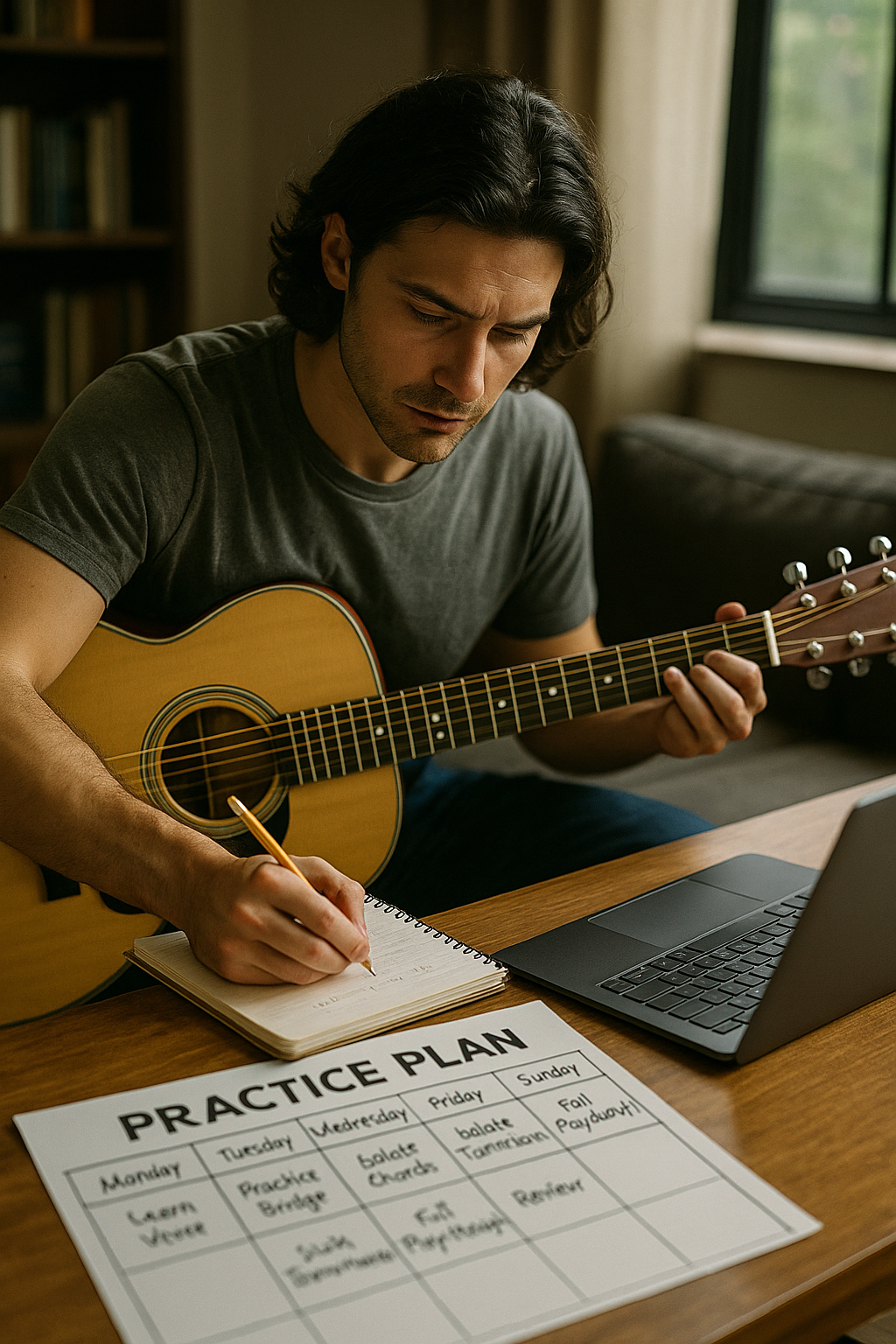Learning an entire song as a beginner can feel like climbing a mountain. You start strong, but then get stuck on tricky parts, overwhelmed by repetition, or unsure how to organize your practice.
The secret? Don’t try to learn the whole song at once.
Instead, break it into manageable sections. This strategy not only speeds up your learning but also builds your confidence, consistency, and musical memory.
In this guide, you’ll learn exactly how to break a song into sections — and how to practice each one effectively — whether you’re learning with sheet music, tabs, or by ear.
Why Breaking a Song Into Sections Works
Trying to learn an entire song from start to finish is like trying to memorize a whole book in one sitting. Your brain and fingers get overloaded.
When you divide the song into chunks, you:
Reduce overwhelm
Focus your attention
Master each part more deeply
Build better muscle memory
Create smoother transitions
Make faster, more enjoyable progress
This technique works for all instruments and music styles — guitar, piano, voice, ukulele, or drums.
Step 1: Listen to the Full Song
Before you start playing, listen to the song a few times to understand its shape.
Ask yourself:
What’s the structure? (Verse, chorus, bridge?)
Which parts repeat?
Are there distinct transitions or changes in energy?
Do any parts sound more complex?
This gives you a mental map of the song — a key first step.
Step 2: Identify the Main Sections
Most songs can be divided into a few core parts:
Intro – the beginning
Verse – tells the story, often changes each time
Chorus – the catchy, repeated hook
Bridge – a contrasting section, often emotional
Instrumental – solo or musical break
Outro – the ending
Write these out or label them in your sheet music, chord chart, or notebook.
Example:
Intro (4 bars)
Verse 1 (8 bars)
Chorus (8 bars)
Verse 2 (8 bars)
Chorus (8 bars)
Bridge (4 bars)
Chorus (8 bars)
Outro (4 bars)
You now have a clear, step-by-step layout to work with.
Step 3: Label Each Section With a Letter
To keep things organized, use letter labels:
A – Verse
B – Chorus
C – Bridge
D – Instrumental or other
Example structure: A – B – A – B – C – B
This helps you visualize repetition and plan your practice sessions.
Step 4: Start With the Easiest Section
Don’t feel like you have to start at the beginning. Choose the section that feels:
Easiest to learn
Most motivating
Most frequently repeated (e.g., the chorus)
This gives you a quick win and builds confidence.
Even learning one section means you’re already partway through the song.
Step 5: Practice One Section at a Time
Work on just one section until you can play it smoothly and confidently.
Tips:
Loop it several times
Play it slowly at first
Use a metronome to build rhythm
Record yourself to check for consistency
Sing or hum along if possible
Don’t move on until it feels comfortable, not perfect.
Step 6: Focus on Transitions
Once you’ve learned two sections, practice the transition between them.
Example: End of verse into chorus
Play the last measure of the verse, then go directly into the chorus
Repeat that transition 3–5 times
Smooth transitions make your full performance flow naturally — and help you stay in tempo.
Step 7: Identify and Isolate Tricky Spots
Find the “speed bumps” — short moments that slow you down.
It could be:
A difficult chord change
A fast finger movement
A rhythmic shift
A melody leap
Don’t avoid these parts. Isolate them and create a micro-practice loop of just that bar or measure.
Use slow motion. Repeat. Gradually speed up.
Even 30 seconds of focused attention can fix a tricky moment.
Step 8: Use a Practice Routine
Organize your practice like this:
5 minutes: Warm-up
10 minutes: Section A (verse)
10 minutes: Section B (chorus)
5 minutes: Transitions or trouble spots
5 minutes: Play what you love or freestyle
This keeps you engaged and avoids overwhelm.
Step 9: Link the Sections Together
Once you’ve learned each part individually, begin connecting them:
Play sections A and B together
Then add C (bridge)
Finally, play A – B – C – B — the full song
You’re building the song like LEGO blocks — one piece at a time.
Step 10: Practice Full Song Flow
After you’ve linked sections together, practice performing the entire song from start to finish.
Try:
Playing with a metronome
Recording yourself
Playing along with the original track
Using a backing track
Don’t stop for small mistakes — treat it like a real performance.
Bonus: Write Down a Practice Map
Example song practice map:
🎯 Monday – Learn intro and verse
🎯 Tuesday – Practice chorus
🎯 Wednesday – Isolate hard spots in verse
🎯 Thursday – Work on transitions
🎯 Friday – Play full song slowly
🎯 Saturday – Full performance
🎯 Sunday – Record and review
This structure turns your song into a clear, trackable journey.
Tools to Help You Break Down Songs
Ultimate Guitar / Chordify – for song structure and chords
YouTube slowed-down versions – great for hard parts
DAWs (GarageBand, BandLab) – mark sections visually
Notebook or practice journal – write sections and notes
Music practice apps – like Modacity, Yousician, or Soundslice
Final Thoughts: Learn Songs Like a Builder
Learning a song isn’t about brute force. It’s about strategy. When you break it into manageable pieces, everything becomes easier, faster, and more fun.
Start with the section you love. Master one part at a time. Connect them slowly. And watch as the full song comes to life — with confidence and flow.
Remember: music isn’t learned in a straight line. It’s built one block at a time — and you’ve got the blueprint.
